Impact of Talent Management on Employee Turnover at British Airways
VerifiedAdded on 2023/01/19
|29
|7393
|83
Project
AI Summary
This research project investigates the impact of talent management on reducing high employee turnover, using British Airways as a case study within the travel and tourism industry. The study explores talent management components, analyzes its importance in retaining employees, and examines the effects of high turnover on business performance. The research incorporates a literature review, research methodology including a questionnaire, data analysis, findings, and discussion, along with recommendations for British Airways to enhance its talent management strategies. The project aims to identify effective ways for British Airways to improve employee retention and overall business performance. Key findings from the literature review highlight the importance of talent acquisition, performance management, and career development in retaining employees and reducing turnover. The project also discusses the negative impacts of high employee turnover, such as reduced revenue and marketing ROI, and proposes strategies for British Airways to improve its talent management practices, including offering career development opportunities.
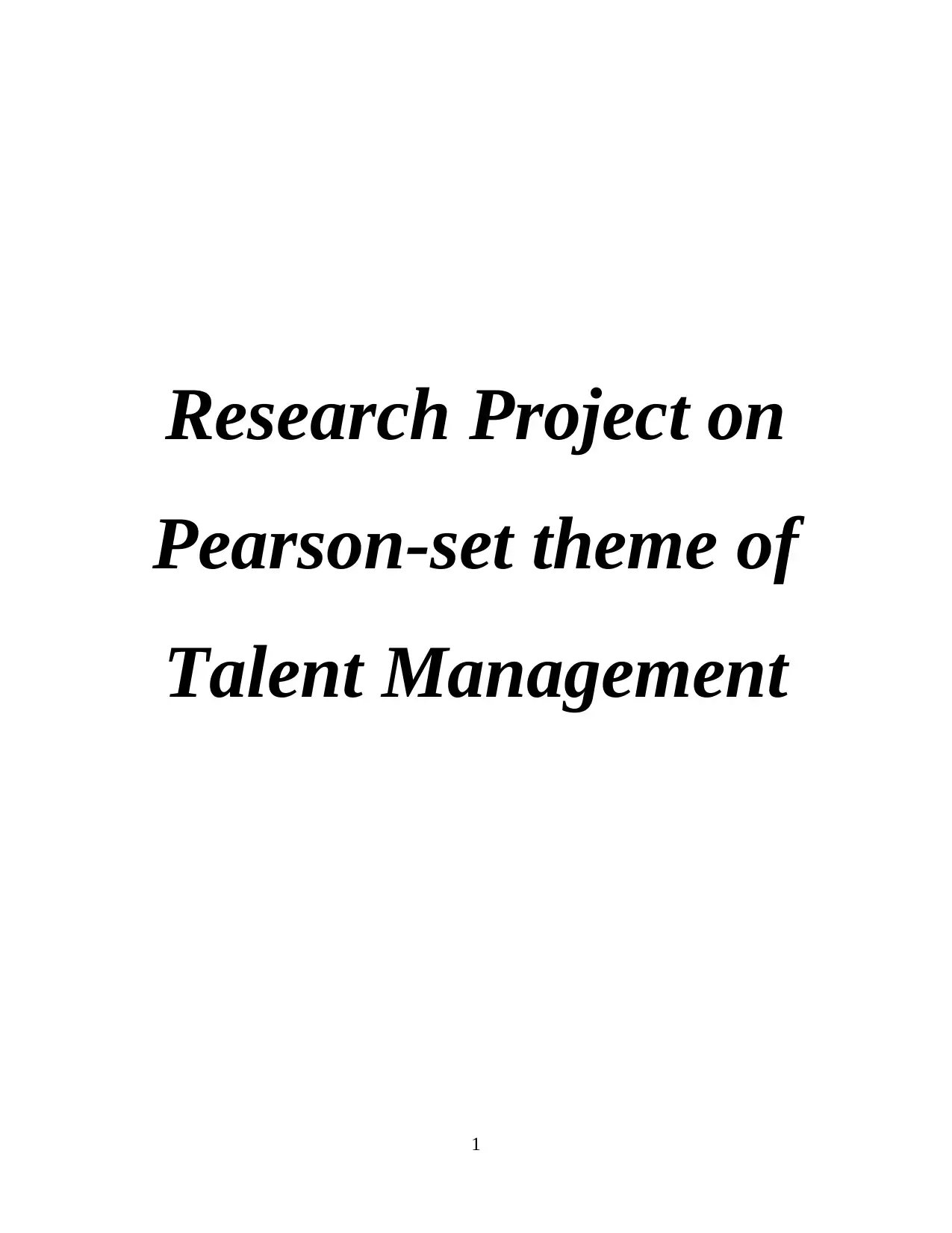
Research Project on
Pearson-set theme of
Talent Management
1
Pearson-set theme of
Talent Management
1
Paraphrase This Document
Need a fresh take? Get an instant paraphrase of this document with our AI Paraphraser
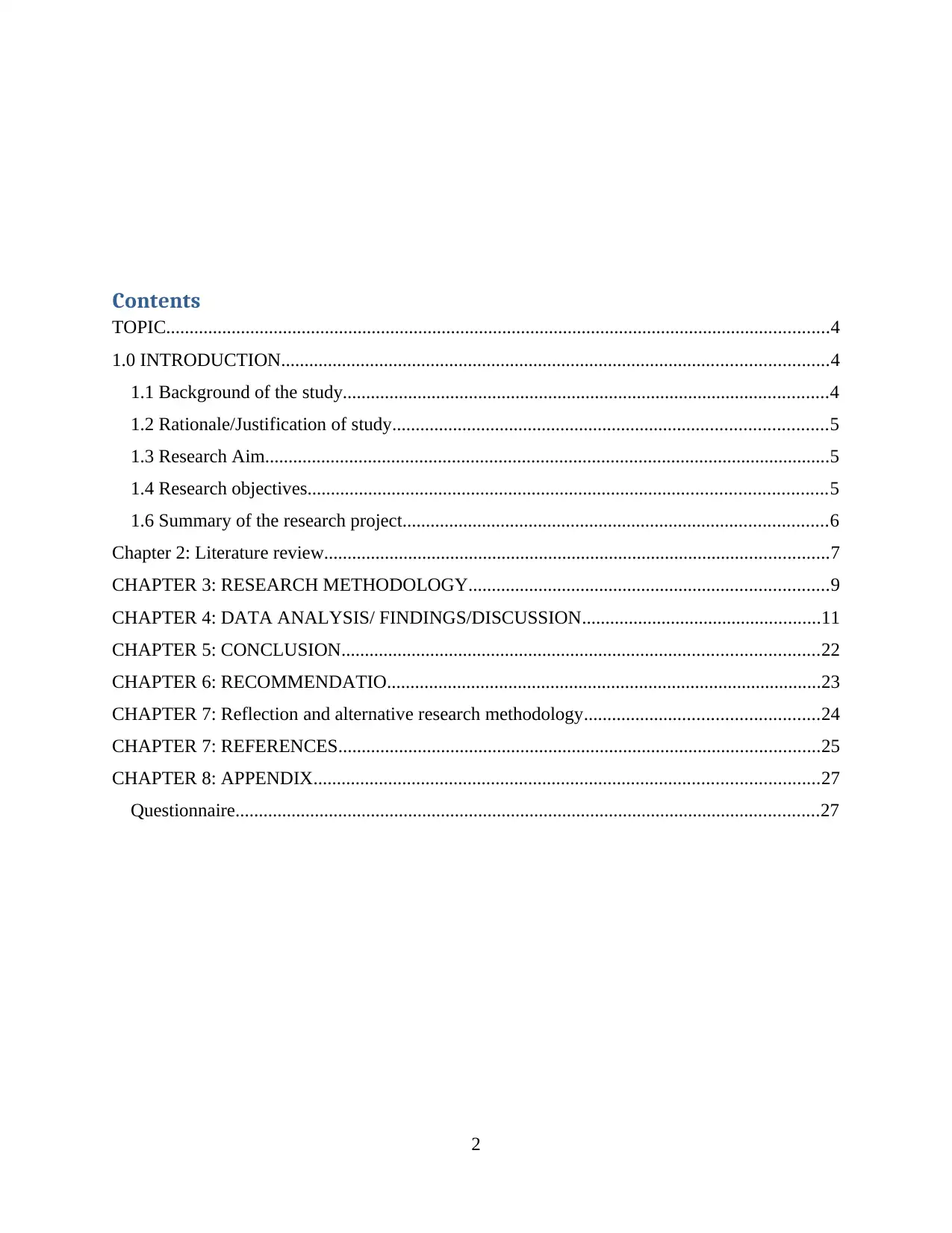
Contents
TOPIC..............................................................................................................................................4
1.0 INTRODUCTION.....................................................................................................................4
1.1 Background of the study........................................................................................................4
1.2 Rationale/Justification of study.............................................................................................5
1.3 Research Aim.........................................................................................................................5
1.4 Research objectives...............................................................................................................5
1.6 Summary of the research project...........................................................................................6
Chapter 2: Literature review............................................................................................................7
CHAPTER 3: RESEARCH METHODOLOGY.............................................................................9
CHAPTER 4: DATA ANALYSIS/ FINDINGS/DISCUSSION...................................................11
CHAPTER 5: CONCLUSION......................................................................................................22
CHAPTER 6: RECOMMENDATIO.............................................................................................23
CHAPTER 7: Reflection and alternative research methodology..................................................24
CHAPTER 7: REFERENCES.......................................................................................................25
CHAPTER 8: APPENDIX............................................................................................................27
Questionnaire.............................................................................................................................27
2
TOPIC..............................................................................................................................................4
1.0 INTRODUCTION.....................................................................................................................4
1.1 Background of the study........................................................................................................4
1.2 Rationale/Justification of study.............................................................................................5
1.3 Research Aim.........................................................................................................................5
1.4 Research objectives...............................................................................................................5
1.6 Summary of the research project...........................................................................................6
Chapter 2: Literature review............................................................................................................7
CHAPTER 3: RESEARCH METHODOLOGY.............................................................................9
CHAPTER 4: DATA ANALYSIS/ FINDINGS/DISCUSSION...................................................11
CHAPTER 5: CONCLUSION......................................................................................................22
CHAPTER 6: RECOMMENDATIO.............................................................................................23
CHAPTER 7: Reflection and alternative research methodology..................................................24
CHAPTER 7: REFERENCES.......................................................................................................25
CHAPTER 8: APPENDIX............................................................................................................27
Questionnaire.............................................................................................................................27
2
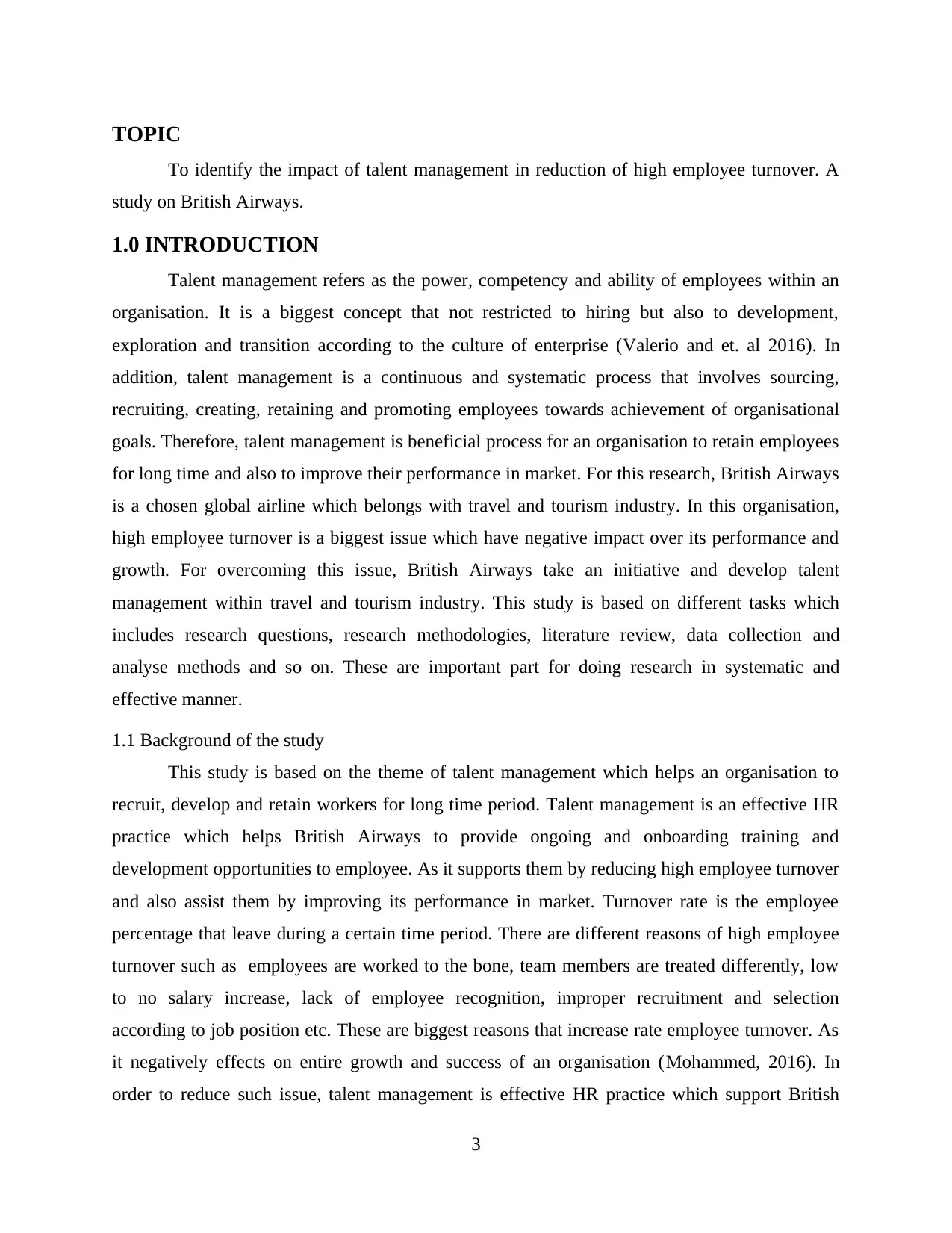
TOPIC
To identify the impact of talent management in reduction of high employee turnover. A
study on British Airways.
1.0 INTRODUCTION
Talent management refers as the power, competency and ability of employees within an
organisation. It is a biggest concept that not restricted to hiring but also to development,
exploration and transition according to the culture of enterprise (Valerio and et. al 2016). In
addition, talent management is a continuous and systematic process that involves sourcing,
recruiting, creating, retaining and promoting employees towards achievement of organisational
goals. Therefore, talent management is beneficial process for an organisation to retain employees
for long time and also to improve their performance in market. For this research, British Airways
is a chosen global airline which belongs with travel and tourism industry. In this organisation,
high employee turnover is a biggest issue which have negative impact over its performance and
growth. For overcoming this issue, British Airways take an initiative and develop talent
management within travel and tourism industry. This study is based on different tasks which
includes research questions, research methodologies, literature review, data collection and
analyse methods and so on. These are important part for doing research in systematic and
effective manner.
1.1 Background of the study
This study is based on the theme of talent management which helps an organisation to
recruit, develop and retain workers for long time period. Talent management is an effective HR
practice which helps British Airways to provide ongoing and onboarding training and
development opportunities to employee. As it supports them by reducing high employee turnover
and also assist them by improving its performance in market. Turnover rate is the employee
percentage that leave during a certain time period. There are different reasons of high employee
turnover such as employees are worked to the bone, team members are treated differently, low
to no salary increase, lack of employee recognition, improper recruitment and selection
according to job position etc. These are biggest reasons that increase rate employee turnover. As
it negatively effects on entire growth and success of an organisation (Mohammed, 2016). In
order to reduce such issue, talent management is effective HR practice which support British
3
To identify the impact of talent management in reduction of high employee turnover. A
study on British Airways.
1.0 INTRODUCTION
Talent management refers as the power, competency and ability of employees within an
organisation. It is a biggest concept that not restricted to hiring but also to development,
exploration and transition according to the culture of enterprise (Valerio and et. al 2016). In
addition, talent management is a continuous and systematic process that involves sourcing,
recruiting, creating, retaining and promoting employees towards achievement of organisational
goals. Therefore, talent management is beneficial process for an organisation to retain employees
for long time and also to improve their performance in market. For this research, British Airways
is a chosen global airline which belongs with travel and tourism industry. In this organisation,
high employee turnover is a biggest issue which have negative impact over its performance and
growth. For overcoming this issue, British Airways take an initiative and develop talent
management within travel and tourism industry. This study is based on different tasks which
includes research questions, research methodologies, literature review, data collection and
analyse methods and so on. These are important part for doing research in systematic and
effective manner.
1.1 Background of the study
This study is based on the theme of talent management which helps an organisation to
recruit, develop and retain workers for long time period. Talent management is an effective HR
practice which helps British Airways to provide ongoing and onboarding training and
development opportunities to employee. As it supports them by reducing high employee turnover
and also assist them by improving its performance in market. Turnover rate is the employee
percentage that leave during a certain time period. There are different reasons of high employee
turnover such as employees are worked to the bone, team members are treated differently, low
to no salary increase, lack of employee recognition, improper recruitment and selection
according to job position etc. These are biggest reasons that increase rate employee turnover. As
it negatively effects on entire growth and success of an organisation (Mohammed, 2016). In
order to reduce such issue, talent management is effective HR practice which support British
3
⊘ This is a preview!⊘
Do you want full access?
Subscribe today to unlock all pages.

Trusted by 1+ million students worldwide
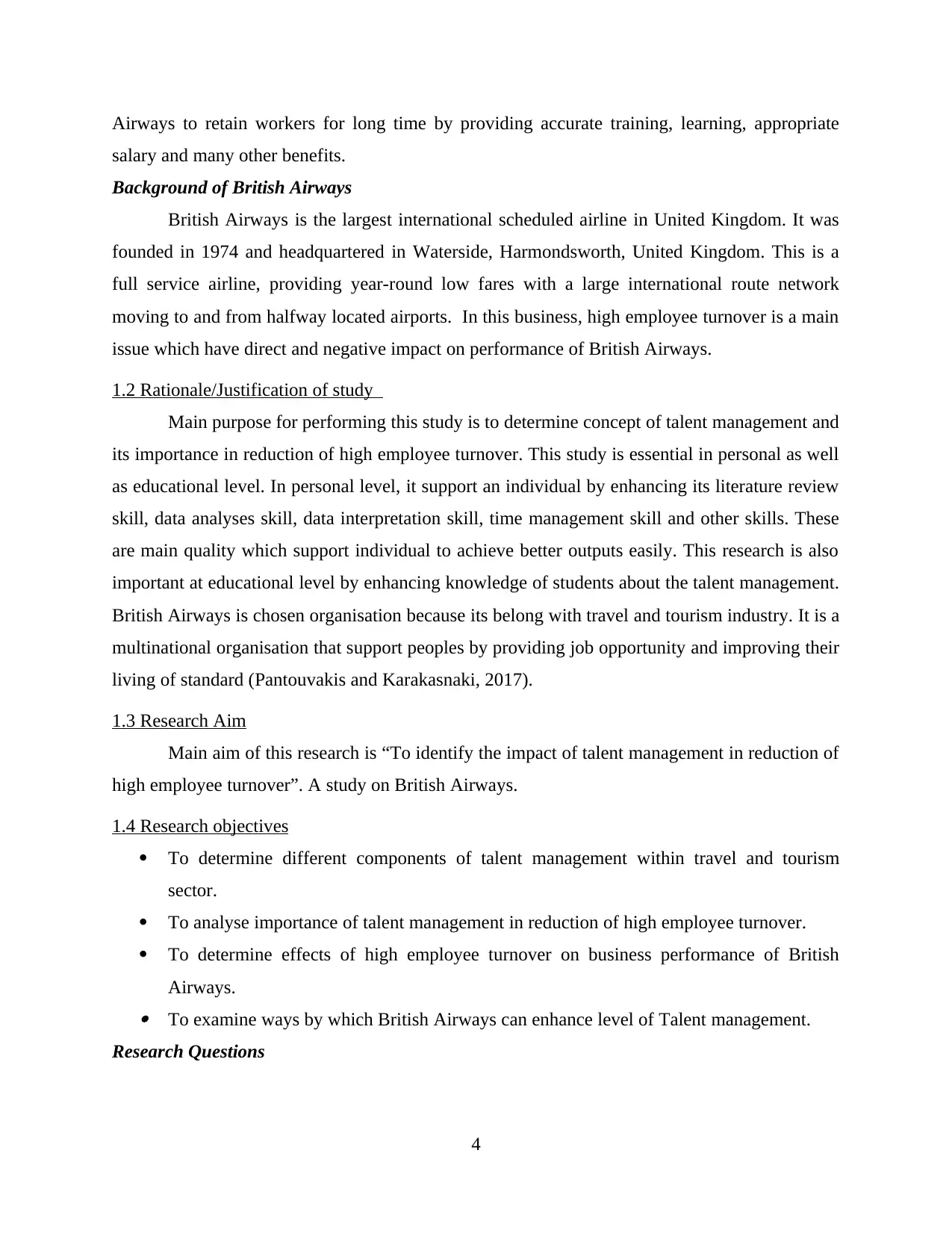
Airways to retain workers for long time by providing accurate training, learning, appropriate
salary and many other benefits.
Background of British Airways
British Airways is the largest international scheduled airline in United Kingdom. It was
founded in 1974 and headquartered in Waterside, Harmondsworth, United Kingdom. This is a
full service airline, providing year-round low fares with a large international route network
moving to and from halfway located airports. In this business, high employee turnover is a main
issue which have direct and negative impact on performance of British Airways.
1.2 Rationale/Justification of study
Main purpose for performing this study is to determine concept of talent management and
its importance in reduction of high employee turnover. This study is essential in personal as well
as educational level. In personal level, it support an individual by enhancing its literature review
skill, data analyses skill, data interpretation skill, time management skill and other skills. These
are main quality which support individual to achieve better outputs easily. This research is also
important at educational level by enhancing knowledge of students about the talent management.
British Airways is chosen organisation because its belong with travel and tourism industry. It is a
multinational organisation that support peoples by providing job opportunity and improving their
living of standard (Pantouvakis and Karakasnaki, 2017).
1.3 Research Aim
Main aim of this research is “To identify the impact of talent management in reduction of
high employee turnover”. A study on British Airways.
1.4 Research objectives
To determine different components of talent management within travel and tourism
sector.
To analyse importance of talent management in reduction of high employee turnover.
To determine effects of high employee turnover on business performance of British
Airways. To examine ways by which British Airways can enhance level of Talent management.
Research Questions
4
salary and many other benefits.
Background of British Airways
British Airways is the largest international scheduled airline in United Kingdom. It was
founded in 1974 and headquartered in Waterside, Harmondsworth, United Kingdom. This is a
full service airline, providing year-round low fares with a large international route network
moving to and from halfway located airports. In this business, high employee turnover is a main
issue which have direct and negative impact on performance of British Airways.
1.2 Rationale/Justification of study
Main purpose for performing this study is to determine concept of talent management and
its importance in reduction of high employee turnover. This study is essential in personal as well
as educational level. In personal level, it support an individual by enhancing its literature review
skill, data analyses skill, data interpretation skill, time management skill and other skills. These
are main quality which support individual to achieve better outputs easily. This research is also
important at educational level by enhancing knowledge of students about the talent management.
British Airways is chosen organisation because its belong with travel and tourism industry. It is a
multinational organisation that support peoples by providing job opportunity and improving their
living of standard (Pantouvakis and Karakasnaki, 2017).
1.3 Research Aim
Main aim of this research is “To identify the impact of talent management in reduction of
high employee turnover”. A study on British Airways.
1.4 Research objectives
To determine different components of talent management within travel and tourism
sector.
To analyse importance of talent management in reduction of high employee turnover.
To determine effects of high employee turnover on business performance of British
Airways. To examine ways by which British Airways can enhance level of Talent management.
Research Questions
4
Paraphrase This Document
Need a fresh take? Get an instant paraphrase of this document with our AI Paraphraser
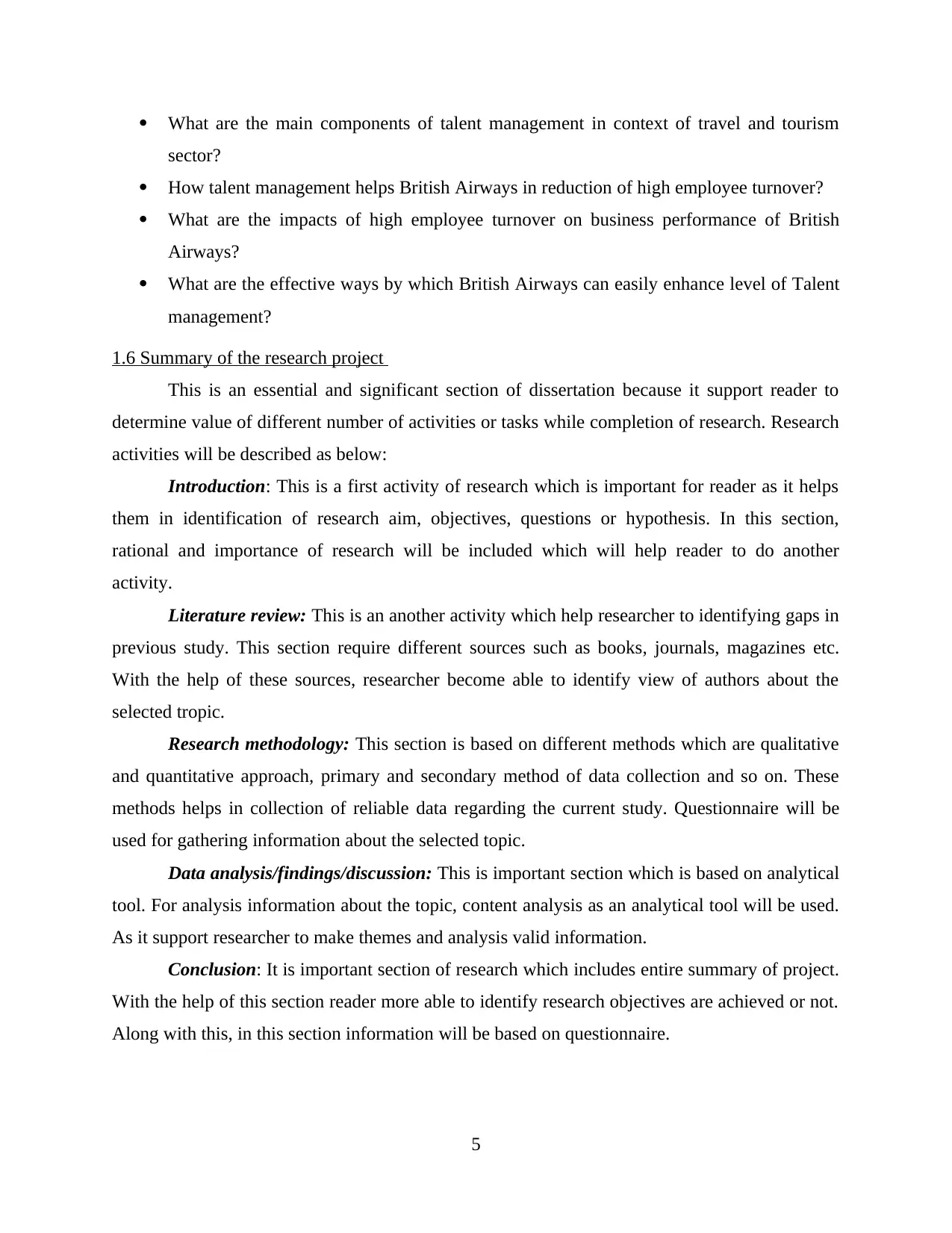
What are the main components of talent management in context of travel and tourism
sector?
How talent management helps British Airways in reduction of high employee turnover?
What are the impacts of high employee turnover on business performance of British
Airways?
What are the effective ways by which British Airways can easily enhance level of Talent
management?
1.6 Summary of the research project
This is an essential and significant section of dissertation because it support reader to
determine value of different number of activities or tasks while completion of research. Research
activities will be described as below:
Introduction: This is a first activity of research which is important for reader as it helps
them in identification of research aim, objectives, questions or hypothesis. In this section,
rational and importance of research will be included which will help reader to do another
activity.
Literature review: This is an another activity which help researcher to identifying gaps in
previous study. This section require different sources such as books, journals, magazines etc.
With the help of these sources, researcher become able to identify view of authors about the
selected tropic.
Research methodology: This section is based on different methods which are qualitative
and quantitative approach, primary and secondary method of data collection and so on. These
methods helps in collection of reliable data regarding the current study. Questionnaire will be
used for gathering information about the selected topic.
Data analysis/findings/discussion: This is important section which is based on analytical
tool. For analysis information about the topic, content analysis as an analytical tool will be used.
As it support researcher to make themes and analysis valid information.
Conclusion: It is important section of research which includes entire summary of project.
With the help of this section reader more able to identify research objectives are achieved or not.
Along with this, in this section information will be based on questionnaire.
5
sector?
How talent management helps British Airways in reduction of high employee turnover?
What are the impacts of high employee turnover on business performance of British
Airways?
What are the effective ways by which British Airways can easily enhance level of Talent
management?
1.6 Summary of the research project
This is an essential and significant section of dissertation because it support reader to
determine value of different number of activities or tasks while completion of research. Research
activities will be described as below:
Introduction: This is a first activity of research which is important for reader as it helps
them in identification of research aim, objectives, questions or hypothesis. In this section,
rational and importance of research will be included which will help reader to do another
activity.
Literature review: This is an another activity which help researcher to identifying gaps in
previous study. This section require different sources such as books, journals, magazines etc.
With the help of these sources, researcher become able to identify view of authors about the
selected tropic.
Research methodology: This section is based on different methods which are qualitative
and quantitative approach, primary and secondary method of data collection and so on. These
methods helps in collection of reliable data regarding the current study. Questionnaire will be
used for gathering information about the selected topic.
Data analysis/findings/discussion: This is important section which is based on analytical
tool. For analysis information about the topic, content analysis as an analytical tool will be used.
As it support researcher to make themes and analysis valid information.
Conclusion: It is important section of research which includes entire summary of project.
With the help of this section reader more able to identify research objectives are achieved or not.
Along with this, in this section information will be based on questionnaire.
5
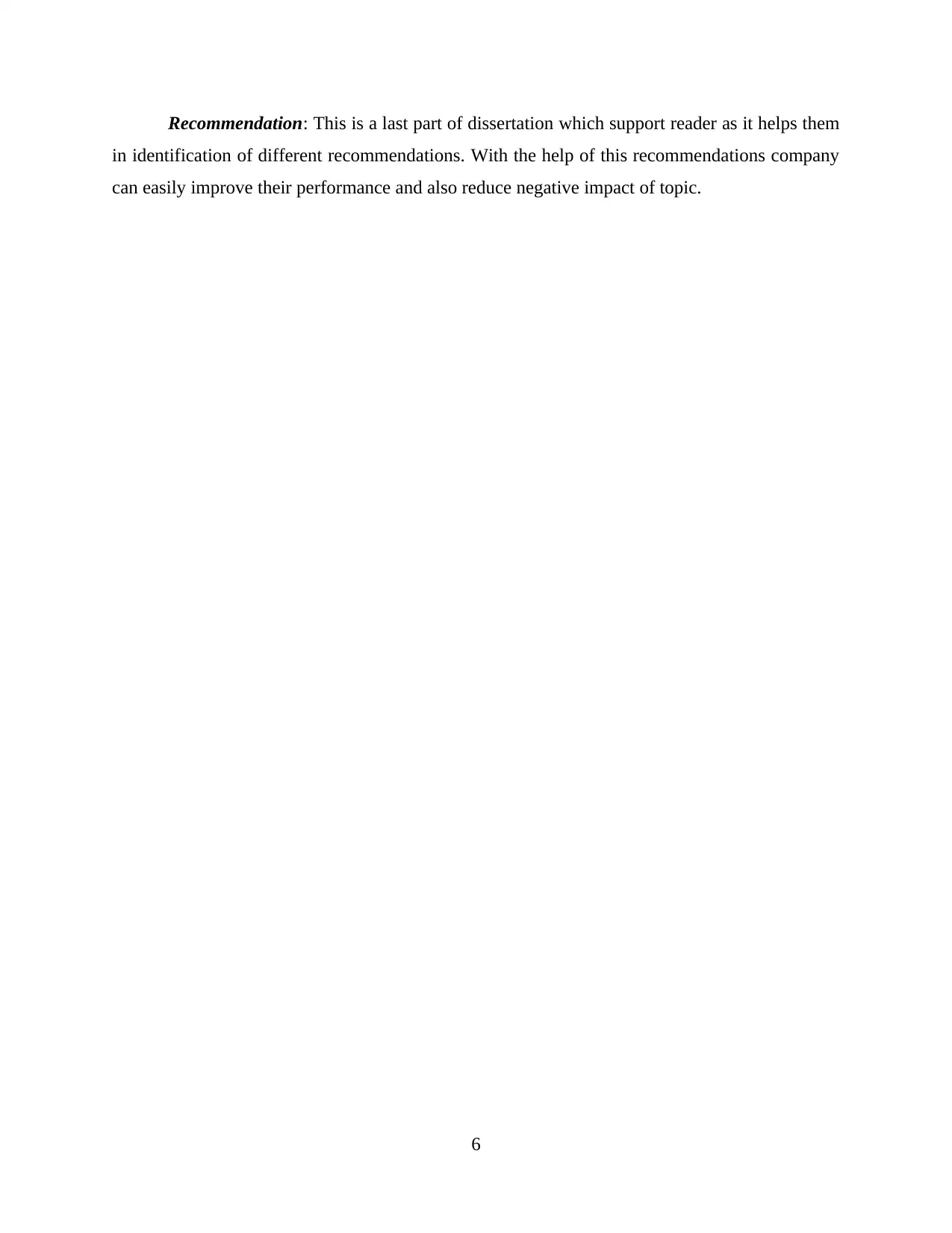
Recommendation: This is a last part of dissertation which support reader as it helps them
in identification of different recommendations. With the help of this recommendations company
can easily improve their performance and also reduce negative impact of topic.
6
in identification of different recommendations. With the help of this recommendations company
can easily improve their performance and also reduce negative impact of topic.
6
⊘ This is a preview!⊘
Do you want full access?
Subscribe today to unlock all pages.

Trusted by 1+ million students worldwide
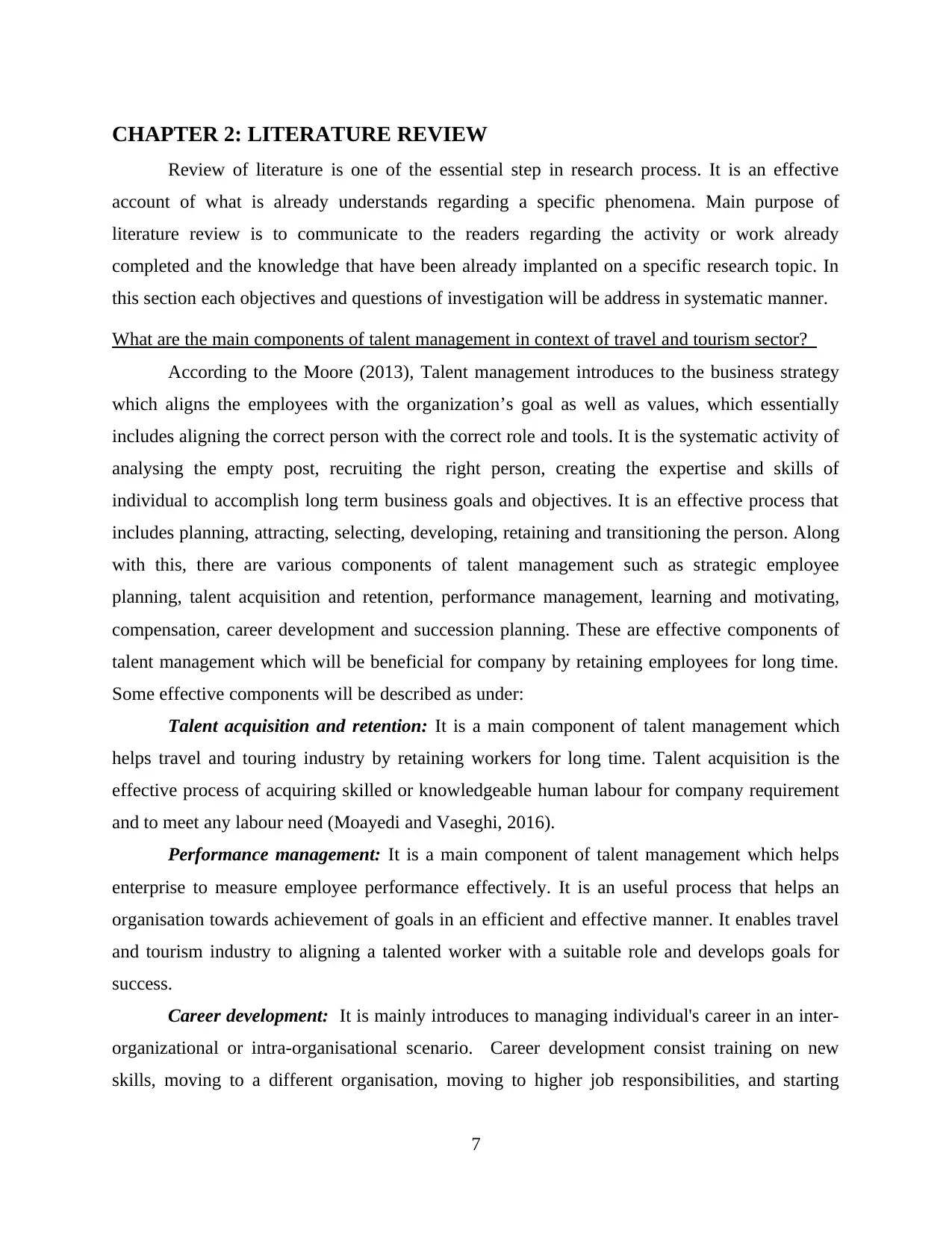
CHAPTER 2: LITERATURE REVIEW
Review of literature is one of the essential step in research process. It is an effective
account of what is already understands regarding a specific phenomena. Main purpose of
literature review is to communicate to the readers regarding the activity or work already
completed and the knowledge that have been already implanted on a specific research topic. In
this section each objectives and questions of investigation will be address in systematic manner.
What are the main components of talent management in context of travel and tourism sector?
According to the Moore (2013), Talent management introduces to the business strategy
which aligns the employees with the organization’s goal as well as values, which essentially
includes aligning the correct person with the correct role and tools. It is the systematic activity of
analysing the empty post, recruiting the right person, creating the expertise and skills of
individual to accomplish long term business goals and objectives. It is an effective process that
includes planning, attracting, selecting, developing, retaining and transitioning the person. Along
with this, there are various components of talent management such as strategic employee
planning, talent acquisition and retention, performance management, learning and motivating,
compensation, career development and succession planning. These are effective components of
talent management which will be beneficial for company by retaining employees for long time.
Some effective components will be described as under:
Talent acquisition and retention: It is a main component of talent management which
helps travel and touring industry by retaining workers for long time. Talent acquisition is the
effective process of acquiring skilled or knowledgeable human labour for company requirement
and to meet any labour need (Moayedi and Vaseghi, 2016).
Performance management: It is a main component of talent management which helps
enterprise to measure employee performance effectively. It is an useful process that helps an
organisation towards achievement of goals in an efficient and effective manner. It enables travel
and tourism industry to aligning a talented worker with a suitable role and develops goals for
success.
Career development: It is mainly introduces to managing individual's career in an inter-
organizational or intra-organisational scenario. Career development consist training on new
skills, moving to a different organisation, moving to higher job responsibilities, and starting
7
Review of literature is one of the essential step in research process. It is an effective
account of what is already understands regarding a specific phenomena. Main purpose of
literature review is to communicate to the readers regarding the activity or work already
completed and the knowledge that have been already implanted on a specific research topic. In
this section each objectives and questions of investigation will be address in systematic manner.
What are the main components of talent management in context of travel and tourism sector?
According to the Moore (2013), Talent management introduces to the business strategy
which aligns the employees with the organization’s goal as well as values, which essentially
includes aligning the correct person with the correct role and tools. It is the systematic activity of
analysing the empty post, recruiting the right person, creating the expertise and skills of
individual to accomplish long term business goals and objectives. It is an effective process that
includes planning, attracting, selecting, developing, retaining and transitioning the person. Along
with this, there are various components of talent management such as strategic employee
planning, talent acquisition and retention, performance management, learning and motivating,
compensation, career development and succession planning. These are effective components of
talent management which will be beneficial for company by retaining employees for long time.
Some effective components will be described as under:
Talent acquisition and retention: It is a main component of talent management which
helps travel and touring industry by retaining workers for long time. Talent acquisition is the
effective process of acquiring skilled or knowledgeable human labour for company requirement
and to meet any labour need (Moayedi and Vaseghi, 2016).
Performance management: It is a main component of talent management which helps
enterprise to measure employee performance effectively. It is an useful process that helps an
organisation towards achievement of goals in an efficient and effective manner. It enables travel
and tourism industry to aligning a talented worker with a suitable role and develops goals for
success.
Career development: It is mainly introduces to managing individual's career in an inter-
organizational or intra-organisational scenario. Career development consist training on new
skills, moving to a different organisation, moving to higher job responsibilities, and starting
7
Paraphrase This Document
Need a fresh take? Get an instant paraphrase of this document with our AI Paraphraser
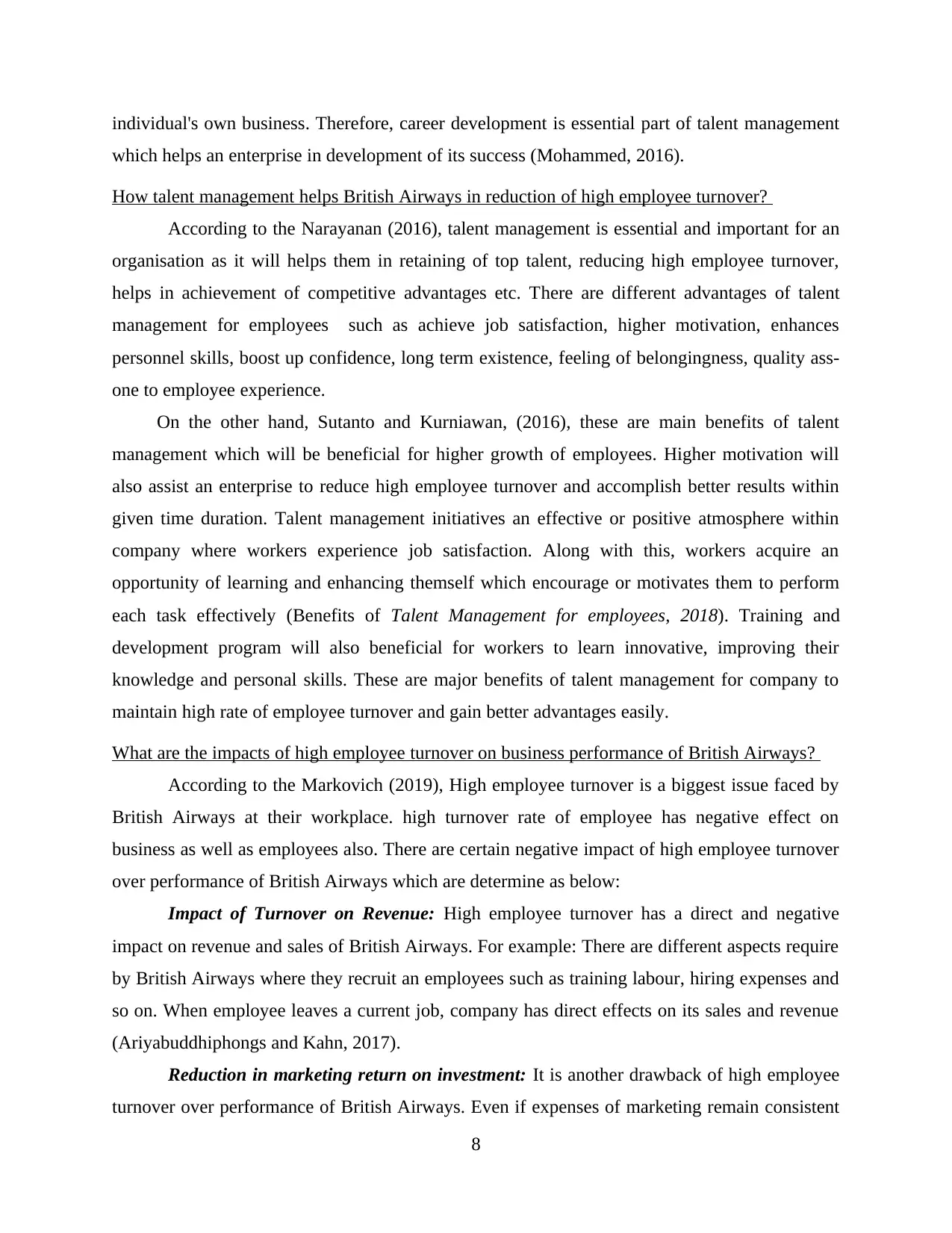
individual's own business. Therefore, career development is essential part of talent management
which helps an enterprise in development of its success (Mohammed, 2016).
How talent management helps British Airways in reduction of high employee turnover?
According to the Narayanan (2016), talent management is essential and important for an
organisation as it will helps them in retaining of top talent, reducing high employee turnover,
helps in achievement of competitive advantages etc. There are different advantages of talent
management for employees such as achieve job satisfaction, higher motivation, enhances
personnel skills, boost up confidence, long term existence, feeling of belongingness, quality ass-
one to employee experience.
On the other hand, Sutanto and Kurniawan, (2016), these are main benefits of talent
management which will be beneficial for higher growth of employees. Higher motivation will
also assist an enterprise to reduce high employee turnover and accomplish better results within
given time duration. Talent management initiatives an effective or positive atmosphere within
company where workers experience job satisfaction. Along with this, workers acquire an
opportunity of learning and enhancing themself which encourage or motivates them to perform
each task effectively (Benefits of Talent Management for employees, 2018). Training and
development program will also beneficial for workers to learn innovative, improving their
knowledge and personal skills. These are major benefits of talent management for company to
maintain high rate of employee turnover and gain better advantages easily.
What are the impacts of high employee turnover on business performance of British Airways?
According to the Markovich (2019), High employee turnover is a biggest issue faced by
British Airways at their workplace. high turnover rate of employee has negative effect on
business as well as employees also. There are certain negative impact of high employee turnover
over performance of British Airways which are determine as below:
Impact of Turnover on Revenue: High employee turnover has a direct and negative
impact on revenue and sales of British Airways. For example: There are different aspects require
by British Airways where they recruit an employees such as training labour, hiring expenses and
so on. When employee leaves a current job, company has direct effects on its sales and revenue
(Ariyabuddhiphongs and Kahn, 2017).
Reduction in marketing return on investment: It is another drawback of high employee
turnover over performance of British Airways. Even if expenses of marketing remain consistent
8
which helps an enterprise in development of its success (Mohammed, 2016).
How talent management helps British Airways in reduction of high employee turnover?
According to the Narayanan (2016), talent management is essential and important for an
organisation as it will helps them in retaining of top talent, reducing high employee turnover,
helps in achievement of competitive advantages etc. There are different advantages of talent
management for employees such as achieve job satisfaction, higher motivation, enhances
personnel skills, boost up confidence, long term existence, feeling of belongingness, quality ass-
one to employee experience.
On the other hand, Sutanto and Kurniawan, (2016), these are main benefits of talent
management which will be beneficial for higher growth of employees. Higher motivation will
also assist an enterprise to reduce high employee turnover and accomplish better results within
given time duration. Talent management initiatives an effective or positive atmosphere within
company where workers experience job satisfaction. Along with this, workers acquire an
opportunity of learning and enhancing themself which encourage or motivates them to perform
each task effectively (Benefits of Talent Management for employees, 2018). Training and
development program will also beneficial for workers to learn innovative, improving their
knowledge and personal skills. These are major benefits of talent management for company to
maintain high rate of employee turnover and gain better advantages easily.
What are the impacts of high employee turnover on business performance of British Airways?
According to the Markovich (2019), High employee turnover is a biggest issue faced by
British Airways at their workplace. high turnover rate of employee has negative effect on
business as well as employees also. There are certain negative impact of high employee turnover
over performance of British Airways which are determine as below:
Impact of Turnover on Revenue: High employee turnover has a direct and negative
impact on revenue and sales of British Airways. For example: There are different aspects require
by British Airways where they recruit an employees such as training labour, hiring expenses and
so on. When employee leaves a current job, company has direct effects on its sales and revenue
(Ariyabuddhiphongs and Kahn, 2017).
Reduction in marketing return on investment: It is another drawback of high employee
turnover over performance of British Airways. Even if expenses of marketing remain consistent
8
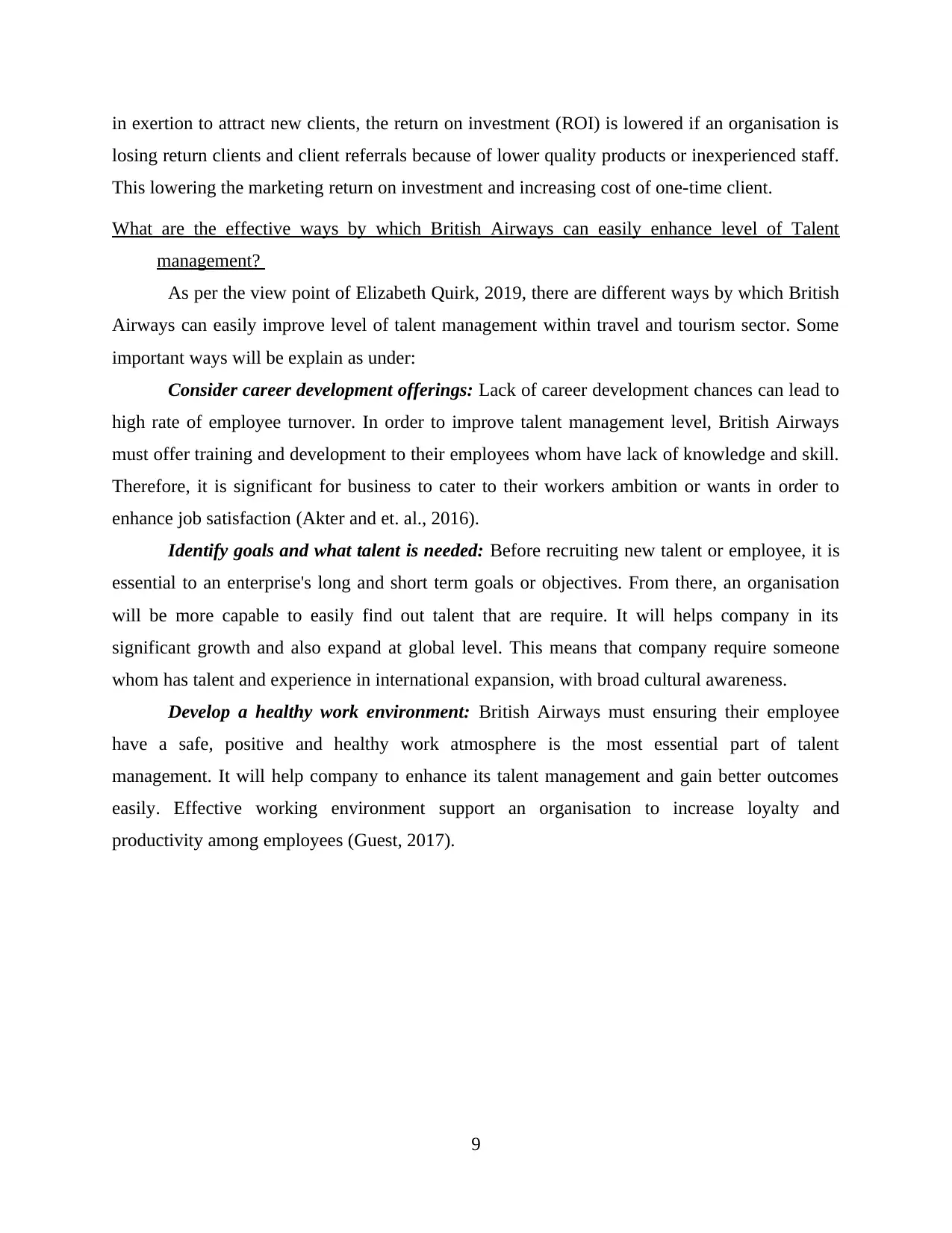
in exertion to attract new clients, the return on investment (ROI) is lowered if an organisation is
losing return clients and client referrals because of lower quality products or inexperienced staff.
This lowering the marketing return on investment and increasing cost of one-time client.
What are the effective ways by which British Airways can easily enhance level of Talent
management?
As per the view point of Elizabeth Quirk, 2019, there are different ways by which British
Airways can easily improve level of talent management within travel and tourism sector. Some
important ways will be explain as under:
Consider career development offerings: Lack of career development chances can lead to
high rate of employee turnover. In order to improve talent management level, British Airways
must offer training and development to their employees whom have lack of knowledge and skill.
Therefore, it is significant for business to cater to their workers ambition or wants in order to
enhance job satisfaction (Akter and et. al., 2016).
Identify goals and what talent is needed: Before recruiting new talent or employee, it is
essential to an enterprise's long and short term goals or objectives. From there, an organisation
will be more capable to easily find out talent that are require. It will helps company in its
significant growth and also expand at global level. This means that company require someone
whom has talent and experience in international expansion, with broad cultural awareness.
Develop a healthy work environment: British Airways must ensuring their employee
have a safe, positive and healthy work atmosphere is the most essential part of talent
management. It will help company to enhance its talent management and gain better outcomes
easily. Effective working environment support an organisation to increase loyalty and
productivity among employees (Guest, 2017).
9
losing return clients and client referrals because of lower quality products or inexperienced staff.
This lowering the marketing return on investment and increasing cost of one-time client.
What are the effective ways by which British Airways can easily enhance level of Talent
management?
As per the view point of Elizabeth Quirk, 2019, there are different ways by which British
Airways can easily improve level of talent management within travel and tourism sector. Some
important ways will be explain as under:
Consider career development offerings: Lack of career development chances can lead to
high rate of employee turnover. In order to improve talent management level, British Airways
must offer training and development to their employees whom have lack of knowledge and skill.
Therefore, it is significant for business to cater to their workers ambition or wants in order to
enhance job satisfaction (Akter and et. al., 2016).
Identify goals and what talent is needed: Before recruiting new talent or employee, it is
essential to an enterprise's long and short term goals or objectives. From there, an organisation
will be more capable to easily find out talent that are require. It will helps company in its
significant growth and also expand at global level. This means that company require someone
whom has talent and experience in international expansion, with broad cultural awareness.
Develop a healthy work environment: British Airways must ensuring their employee
have a safe, positive and healthy work atmosphere is the most essential part of talent
management. It will help company to enhance its talent management and gain better outcomes
easily. Effective working environment support an organisation to increase loyalty and
productivity among employees (Guest, 2017).
9
⊘ This is a preview!⊘
Do you want full access?
Subscribe today to unlock all pages.

Trusted by 1+ million students worldwide
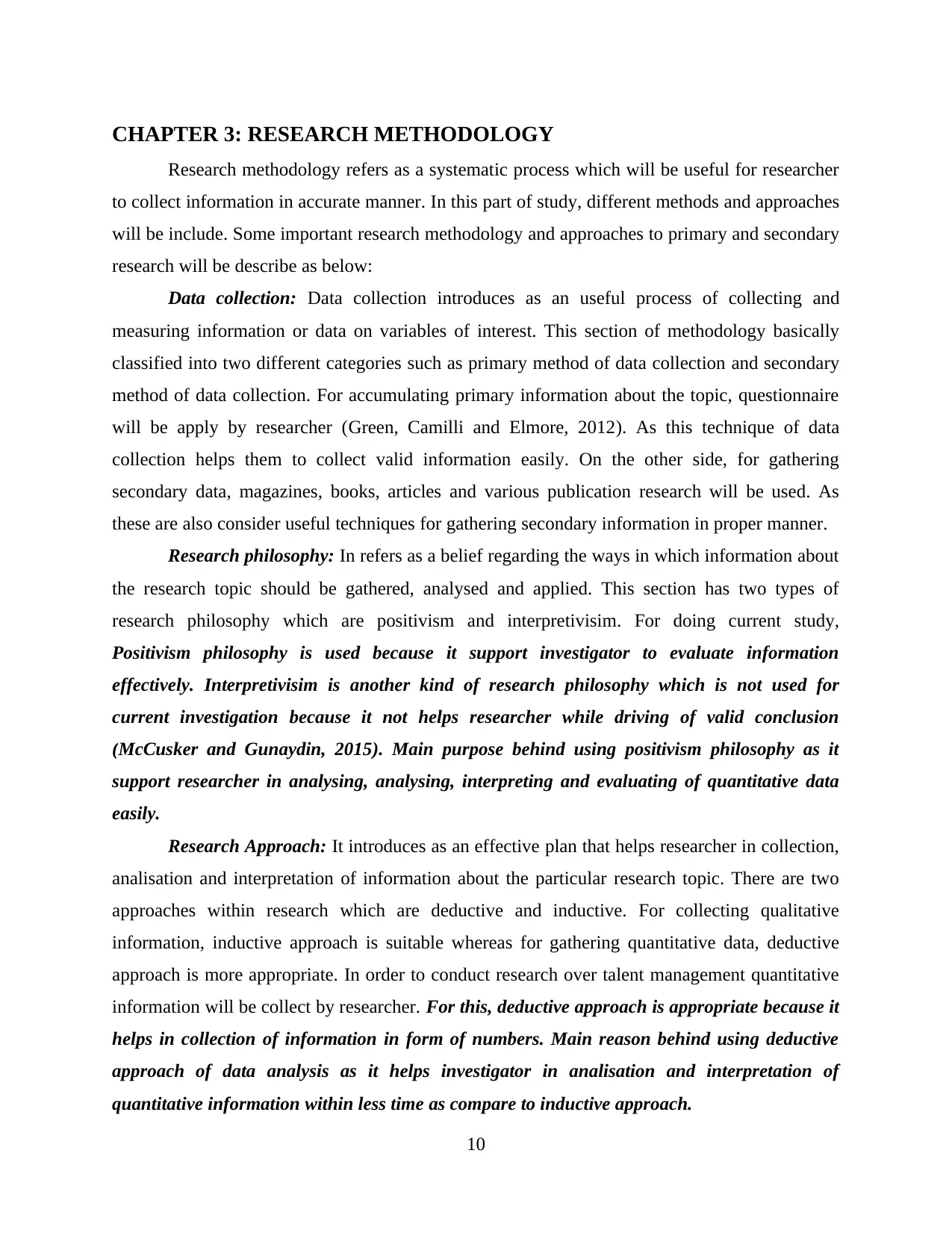
CHAPTER 3: RESEARCH METHODOLOGY
Research methodology refers as a systematic process which will be useful for researcher
to collect information in accurate manner. In this part of study, different methods and approaches
will be include. Some important research methodology and approaches to primary and secondary
research will be describe as below:
Data collection: Data collection introduces as an useful process of collecting and
measuring information or data on variables of interest. This section of methodology basically
classified into two different categories such as primary method of data collection and secondary
method of data collection. For accumulating primary information about the topic, questionnaire
will be apply by researcher (Green, Camilli and Elmore, 2012). As this technique of data
collection helps them to collect valid information easily. On the other side, for gathering
secondary data, magazines, books, articles and various publication research will be used. As
these are also consider useful techniques for gathering secondary information in proper manner.
Research philosophy: In refers as a belief regarding the ways in which information about
the research topic should be gathered, analysed and applied. This section has two types of
research philosophy which are positivism and interpretivisim. For doing current study,
Positivism philosophy is used because it support investigator to evaluate information
effectively. Interpretivisim is another kind of research philosophy which is not used for
current investigation because it not helps researcher while driving of valid conclusion
(McCusker and Gunaydin, 2015). Main purpose behind using positivism philosophy as it
support researcher in analysing, analysing, interpreting and evaluating of quantitative data
easily.
Research Approach: It introduces as an effective plan that helps researcher in collection,
analisation and interpretation of information about the particular research topic. There are two
approaches within research which are deductive and inductive. For collecting qualitative
information, inductive approach is suitable whereas for gathering quantitative data, deductive
approach is more appropriate. In order to conduct research over talent management quantitative
information will be collect by researcher. For this, deductive approach is appropriate because it
helps in collection of information in form of numbers. Main reason behind using deductive
approach of data analysis as it helps investigator in analisation and interpretation of
quantitative information within less time as compare to inductive approach.
10
Research methodology refers as a systematic process which will be useful for researcher
to collect information in accurate manner. In this part of study, different methods and approaches
will be include. Some important research methodology and approaches to primary and secondary
research will be describe as below:
Data collection: Data collection introduces as an useful process of collecting and
measuring information or data on variables of interest. This section of methodology basically
classified into two different categories such as primary method of data collection and secondary
method of data collection. For accumulating primary information about the topic, questionnaire
will be apply by researcher (Green, Camilli and Elmore, 2012). As this technique of data
collection helps them to collect valid information easily. On the other side, for gathering
secondary data, magazines, books, articles and various publication research will be used. As
these are also consider useful techniques for gathering secondary information in proper manner.
Research philosophy: In refers as a belief regarding the ways in which information about
the research topic should be gathered, analysed and applied. This section has two types of
research philosophy which are positivism and interpretivisim. For doing current study,
Positivism philosophy is used because it support investigator to evaluate information
effectively. Interpretivisim is another kind of research philosophy which is not used for
current investigation because it not helps researcher while driving of valid conclusion
(McCusker and Gunaydin, 2015). Main purpose behind using positivism philosophy as it
support researcher in analysing, analysing, interpreting and evaluating of quantitative data
easily.
Research Approach: It introduces as an effective plan that helps researcher in collection,
analisation and interpretation of information about the particular research topic. There are two
approaches within research which are deductive and inductive. For collecting qualitative
information, inductive approach is suitable whereas for gathering quantitative data, deductive
approach is more appropriate. In order to conduct research over talent management quantitative
information will be collect by researcher. For this, deductive approach is appropriate because it
helps in collection of information in form of numbers. Main reason behind using deductive
approach of data analysis as it helps investigator in analisation and interpretation of
quantitative information within less time as compare to inductive approach.
10
Paraphrase This Document
Need a fresh take? Get an instant paraphrase of this document with our AI Paraphraser
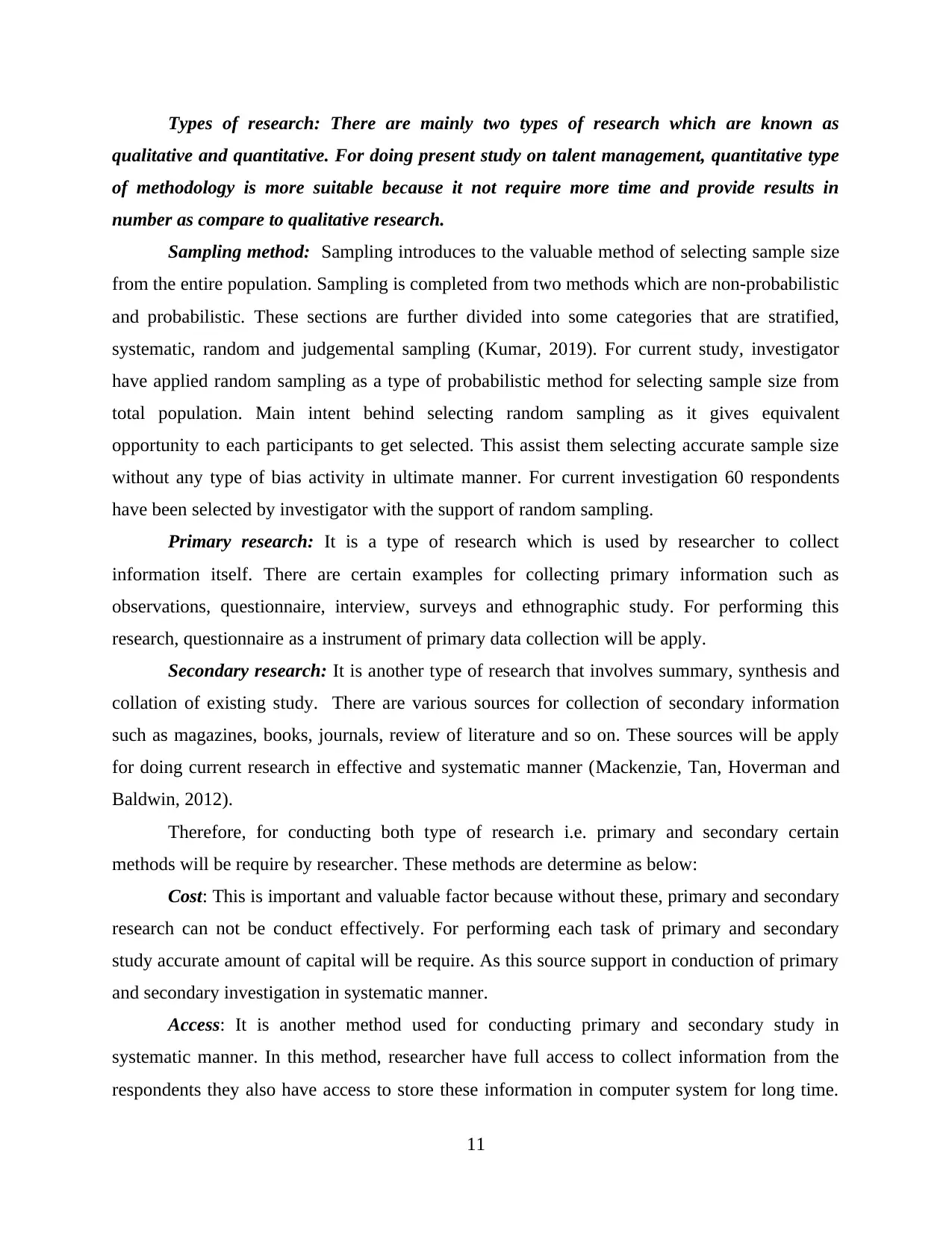
Types of research: There are mainly two types of research which are known as
qualitative and quantitative. For doing present study on talent management, quantitative type
of methodology is more suitable because it not require more time and provide results in
number as compare to qualitative research.
Sampling method: Sampling introduces to the valuable method of selecting sample size
from the entire population. Sampling is completed from two methods which are non-probabilistic
and probabilistic. These sections are further divided into some categories that are stratified,
systematic, random and judgemental sampling (Kumar, 2019). For current study, investigator
have applied random sampling as a type of probabilistic method for selecting sample size from
total population. Main intent behind selecting random sampling as it gives equivalent
opportunity to each participants to get selected. This assist them selecting accurate sample size
without any type of bias activity in ultimate manner. For current investigation 60 respondents
have been selected by investigator with the support of random sampling.
Primary research: It is a type of research which is used by researcher to collect
information itself. There are certain examples for collecting primary information such as
observations, questionnaire, interview, surveys and ethnographic study. For performing this
research, questionnaire as a instrument of primary data collection will be apply.
Secondary research: It is another type of research that involves summary, synthesis and
collation of existing study. There are various sources for collection of secondary information
such as magazines, books, journals, review of literature and so on. These sources will be apply
for doing current research in effective and systematic manner (Mackenzie, Tan, Hoverman and
Baldwin, 2012).
Therefore, for conducting both type of research i.e. primary and secondary certain
methods will be require by researcher. These methods are determine as below:
Cost: This is important and valuable factor because without these, primary and secondary
research can not be conduct effectively. For performing each task of primary and secondary
study accurate amount of capital will be require. As this source support in conduction of primary
and secondary investigation in systematic manner.
Access: It is another method used for conducting primary and secondary study in
systematic manner. In this method, researcher have full access to collect information from the
respondents they also have access to store these information in computer system for long time.
11
qualitative and quantitative. For doing present study on talent management, quantitative type
of methodology is more suitable because it not require more time and provide results in
number as compare to qualitative research.
Sampling method: Sampling introduces to the valuable method of selecting sample size
from the entire population. Sampling is completed from two methods which are non-probabilistic
and probabilistic. These sections are further divided into some categories that are stratified,
systematic, random and judgemental sampling (Kumar, 2019). For current study, investigator
have applied random sampling as a type of probabilistic method for selecting sample size from
total population. Main intent behind selecting random sampling as it gives equivalent
opportunity to each participants to get selected. This assist them selecting accurate sample size
without any type of bias activity in ultimate manner. For current investigation 60 respondents
have been selected by investigator with the support of random sampling.
Primary research: It is a type of research which is used by researcher to collect
information itself. There are certain examples for collecting primary information such as
observations, questionnaire, interview, surveys and ethnographic study. For performing this
research, questionnaire as a instrument of primary data collection will be apply.
Secondary research: It is another type of research that involves summary, synthesis and
collation of existing study. There are various sources for collection of secondary information
such as magazines, books, journals, review of literature and so on. These sources will be apply
for doing current research in effective and systematic manner (Mackenzie, Tan, Hoverman and
Baldwin, 2012).
Therefore, for conducting both type of research i.e. primary and secondary certain
methods will be require by researcher. These methods are determine as below:
Cost: This is important and valuable factor because without these, primary and secondary
research can not be conduct effectively. For performing each task of primary and secondary
study accurate amount of capital will be require. As this source support in conduction of primary
and secondary investigation in systematic manner.
Access: It is another method used for conducting primary and secondary study in
systematic manner. In this method, researcher have full access to collect information from the
respondents they also have access to store these information in computer system for long time.
11
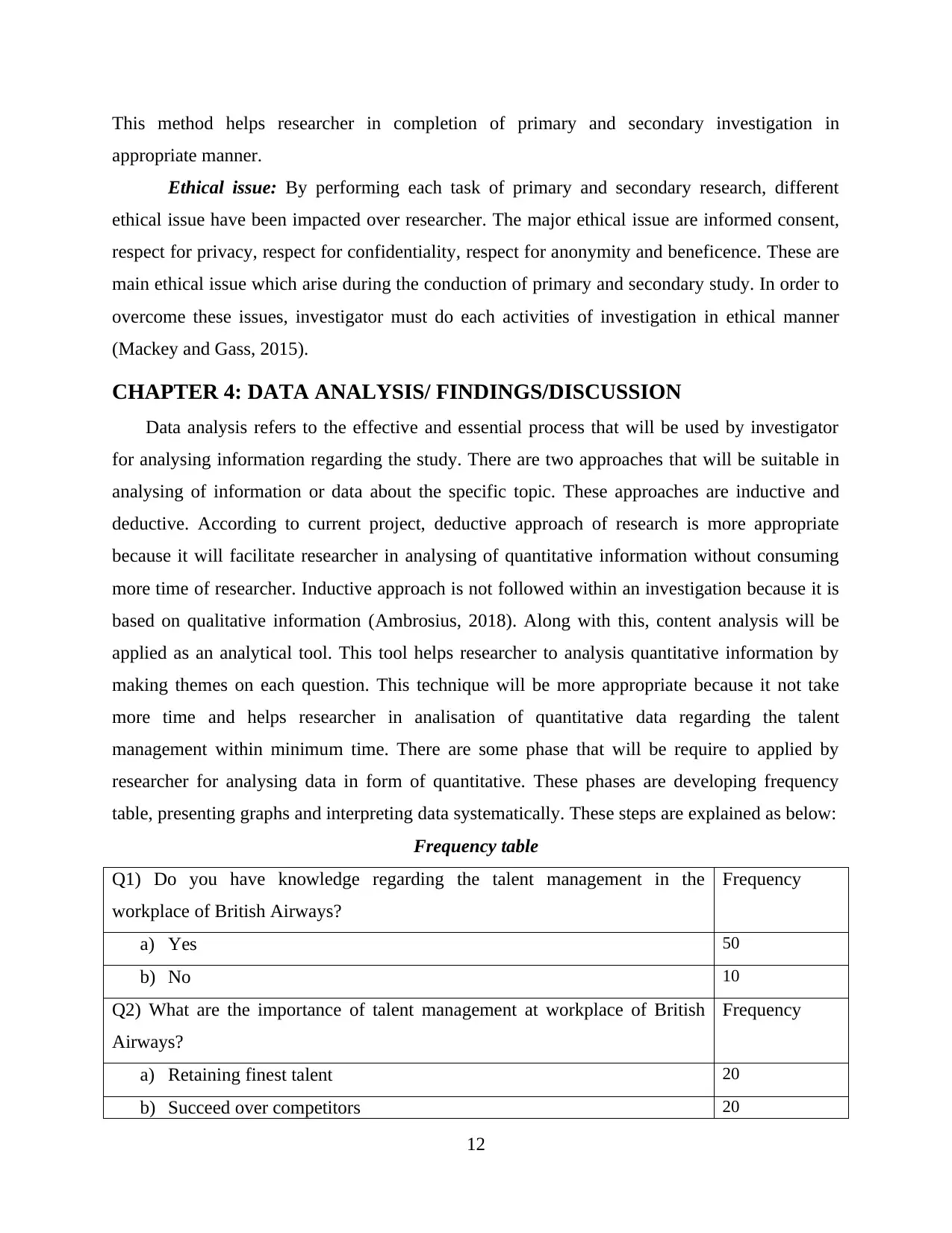
This method helps researcher in completion of primary and secondary investigation in
appropriate manner.
Ethical issue: By performing each task of primary and secondary research, different
ethical issue have been impacted over researcher. The major ethical issue are informed consent,
respect for privacy, respect for confidentiality, respect for anonymity and beneficence. These are
main ethical issue which arise during the conduction of primary and secondary study. In order to
overcome these issues, investigator must do each activities of investigation in ethical manner
(Mackey and Gass, 2015).
CHAPTER 4: DATA ANALYSIS/ FINDINGS/DISCUSSION
Data analysis refers to the effective and essential process that will be used by investigator
for analysing information regarding the study. There are two approaches that will be suitable in
analysing of information or data about the specific topic. These approaches are inductive and
deductive. According to current project, deductive approach of research is more appropriate
because it will facilitate researcher in analysing of quantitative information without consuming
more time of researcher. Inductive approach is not followed within an investigation because it is
based on qualitative information (Ambrosius, 2018). Along with this, content analysis will be
applied as an analytical tool. This tool helps researcher to analysis quantitative information by
making themes on each question. This technique will be more appropriate because it not take
more time and helps researcher in analisation of quantitative data regarding the talent
management within minimum time. There are some phase that will be require to applied by
researcher for analysing data in form of quantitative. These phases are developing frequency
table, presenting graphs and interpreting data systematically. These steps are explained as below:
Frequency table
Q1) Do you have knowledge regarding the talent management in the
workplace of British Airways?
Frequency
a) Yes 50
b) No 10
Q2) What are the importance of talent management at workplace of British
Airways?
Frequency
a) Retaining finest talent 20
b) Succeed over competitors 20
12
appropriate manner.
Ethical issue: By performing each task of primary and secondary research, different
ethical issue have been impacted over researcher. The major ethical issue are informed consent,
respect for privacy, respect for confidentiality, respect for anonymity and beneficence. These are
main ethical issue which arise during the conduction of primary and secondary study. In order to
overcome these issues, investigator must do each activities of investigation in ethical manner
(Mackey and Gass, 2015).
CHAPTER 4: DATA ANALYSIS/ FINDINGS/DISCUSSION
Data analysis refers to the effective and essential process that will be used by investigator
for analysing information regarding the study. There are two approaches that will be suitable in
analysing of information or data about the specific topic. These approaches are inductive and
deductive. According to current project, deductive approach of research is more appropriate
because it will facilitate researcher in analysing of quantitative information without consuming
more time of researcher. Inductive approach is not followed within an investigation because it is
based on qualitative information (Ambrosius, 2018). Along with this, content analysis will be
applied as an analytical tool. This tool helps researcher to analysis quantitative information by
making themes on each question. This technique will be more appropriate because it not take
more time and helps researcher in analisation of quantitative data regarding the talent
management within minimum time. There are some phase that will be require to applied by
researcher for analysing data in form of quantitative. These phases are developing frequency
table, presenting graphs and interpreting data systematically. These steps are explained as below:
Frequency table
Q1) Do you have knowledge regarding the talent management in the
workplace of British Airways?
Frequency
a) Yes 50
b) No 10
Q2) What are the importance of talent management at workplace of British
Airways?
Frequency
a) Retaining finest talent 20
b) Succeed over competitors 20
12
⊘ This is a preview!⊘
Do you want full access?
Subscribe today to unlock all pages.

Trusted by 1+ million students worldwide
1 out of 29
Related Documents
Your All-in-One AI-Powered Toolkit for Academic Success.
+13062052269
info@desklib.com
Available 24*7 on WhatsApp / Email
![[object Object]](/_next/static/media/star-bottom.7253800d.svg)
Unlock your academic potential
Copyright © 2020–2025 A2Z Services. All Rights Reserved. Developed and managed by ZUCOL.





